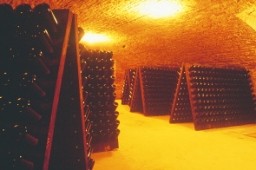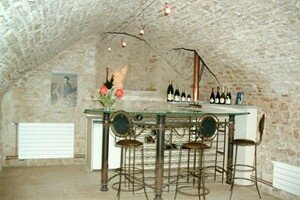The different types of Champagne... and how to read the labels
The different types of Champagne...
© CICV S.T.
...and how to read the labels
The categories of Champagne
The following are the six categories of Champagne, that are mentioned on the labels. The order in which they appear is not by order of the quality.
Vintage Year Champagne (Millésimé)
Every year can not be a vintage year. A vintage wine is special because it means that the year was a good year, even exceptional in terms of grapes and harvest. As usually Champagne is made by blending crus from different years, a vintage champagne is made of exclusively the year's harvest, and is matured at least 3 years before being reaching the market.
Prestige Vintage
(Cuvée de prestige)
It is the 'top' of the champagne producing house. It may or may not be vintage.
These vintages represent around 1% of the French consumption.

Les caves © Ph. Praliaud / CDT Aube
Blanc-de-blancs
Made only with white grapes (pure Chardonnay), it may also be called just Chardonnay. This gives a light, fresh wine in which in which are detectable the typical aromas of this grape variety, such as the grapefruit for example.
Blanc-de-noirs
Made by the red grape types (Pinot noir or Pinot Meunier), the Blanc-de-noirs are strong, complex and structured wines.
Brut (no year)
This is the blending of different grape varieties, different years and different vineyards. It is by far the largest production of Champagne types. The Champagne is matured for at least 15 months on the wooden panels before it is put up for sale.
Very often the quality of the house is judged by the quality of this "basic" Champagne.

Champagne Jacques Defrance - La cave
© Sedecs/Terroirs-of-France - M. Durman
Champagne rosé
This Champagne is usually mixed with a still red Champagne wine to obtain the required shade. This is a difficult operation as the red wine should not change the initial character of the cuvée. Another method used is by crushing the grapes followed by a maceration of the juice in contact with the skins of the grapes before pressing the grapes. This leads to the coloring and the flavor of a pink wine.
The vintages of Champagne
Although 250 wine-growing towns participate in the production of Champagne, there are only 17 grands crus (vintages).
The producers
Indicated in small capital letters at the bottom of the label.
N. M. : Négociant-Manipulant.
He makes or produces the wine. A brand of a négociant indicates a négociant-manipulant. M. A. : Marque d'Acheteur.
This is a secondary brand, found usually in supermarkets at lower prices because it is a less known wine, but not of a lesser quality.
R. M. : Récoltant-Manipulant.
He harvests and then produces the wines.
C. M. : Coopérative-Manipulante.
In the same way, he produces wine by the grapes harvested by others (members).
C. R. : Coopérateur-Récoltant.
He brings his grapes to be produced at the cooperation of which he is a member.
S. R. : Société de Récoltants.
It is a wine producers association.
Champagne grapes
Champagne boasts three grape varieties, and single-variety Champagnes are less common.
In most Champagnes, Pinot Meunier contributes to immediate fruitiness; Chardonnay gives finesse, longevity and flavors ranging from citrus to the very strong toasty flavors of maturity; and Pinot Noir adds an appley fruitiness initially, and ages well towards red fruit flavors. The color of rosé Champagnes has to come from Pinot Noir.
Chardonnay :
This world-famous white grape has spread right across the world from its original home in Burgundy. It makes the most famous dry white wines in the world. Chardonnays range from simple, lemony, appley wines to rich, opulent ones with honey, hazelnut, toast, butter, pineapple flavors … Some, such as fine white Burgundies, age extremely well. Chardonnay is one of the three Champagne grapes types, and the only type in Blanc de Blancs Champagnes. Pinot Meunier :
A close variety of the Pinot Noir, this red grape is one of the Champagne trio. It makes white wine, since the juice is squeezed quickly off the colored skins. Very occasionally it is vinified on its own in the Marne Valley, where it can make very full-bodied Champagnes not without finesse.
Pinot Noir :
The grape of the great red Burgundies, Pinot Noir probably originated in Burgundy. It ripens early, producing ruby-colored wines with delicious savory raspberry aromas, with firm tannins and fine acidity, developing exceptional aromas as they age. Pinot Noir is an important Champagne grape variety, indispensable for rosé and blanc de noirs Champagnes.
Outside France, wine producers are beginning to master the Pinot Noir in New Zealand, Germany, the USA and Australia.
We would like to thank the CDT of Aube for the information provided.


/https%3A%2F%2Fprofilepics.canalblog.com%2Fprofilepics%2F2%2F6%2F267002.jpg)


/https%3A%2F%2Fstorage.canalblog.com%2F40%2F39%2F309584%2F127054063_o.jpg)
/https%3A%2F%2Fstorage.canalblog.com%2F94%2F69%2F309584%2F127026414_o.jpg)
/https%3A%2F%2Fstorage.canalblog.com%2F13%2F22%2F309584%2F127013488_o.jpg)
/https%3A%2F%2Fstorage.canalblog.com%2F39%2F95%2F309584%2F126987670_o.jpg)